[English] 日本語
 Yorodumi
Yorodumi- PDB-5ck3: Signal recognition particle receptor SRb-GTP/SRX complex from Cha... -
+ Open data
Open data
- Basic information
Basic information
| Entry | Database: PDB / ID: 5ck3 | ||||||
|---|---|---|---|---|---|---|---|
| Title | Signal recognition particle receptor SRb-GTP/SRX complex from Chaetomium thermophilum | ||||||
 Components Components |
| ||||||
 Keywords Keywords | SIGNALING PROTEIN / GTPase / Longin domain / regulator complex / protein translocation | ||||||
| Function / homology |  Function and homology information Function and homology informationhistone H4S1 kinase activity / : / histone H3S57 kinase activity / histone H2BS14 kinase activity / signal recognition particle receptor complex / histone H3S28 kinase activity / histone H2AS1 kinase activity / histone H3T6 kinase activity / ribosomal protein S6 kinase activity / histone H2AT120 kinase activity ...histone H4S1 kinase activity / : / histone H3S57 kinase activity / histone H2BS14 kinase activity / signal recognition particle receptor complex / histone H3S28 kinase activity / histone H2AS1 kinase activity / histone H3T6 kinase activity / ribosomal protein S6 kinase activity / histone H2AT120 kinase activity / histone H2BS36 kinase activity / Rho-dependent protein serine/threonine kinase activity / AMP-activated protein kinase activity / eukaryotic translation initiation factor 2alpha kinase activity / histone H3T3 kinase activity / 3-phosphoinositide-dependent protein kinase activity / histone H3T45 kinase activity / signal recognition particle binding / DNA-dependent protein kinase activity / histone H2AXS139 kinase activity / histone H3T11 kinase activity / SRP-dependent cotranslational protein targeting to membrane / histone H3S10 kinase activity / telomere maintenance / DNA damage checkpoint signaling / intracellular protein transport / chromosome / non-specific serine/threonine protein kinase / DNA repair / GTPase activity / endoplasmic reticulum membrane / GTP binding / ATP hydrolysis activity / metal ion binding / nucleus Similarity search - Function | ||||||
| Biological species |  Chaetomium thermophilum (fungus) Chaetomium thermophilum (fungus) | ||||||
| Method |  X-RAY DIFFRACTION / X-RAY DIFFRACTION /  SYNCHROTRON / SYNCHROTRON /  MOLECULAR REPLACEMENT / Resolution: 3.2 Å MOLECULAR REPLACEMENT / Resolution: 3.2 Å | ||||||
 Authors Authors | Jadhav, B.R. / Wild, K. / Sinning, I. | ||||||
 Citation Citation |  Journal: Structure / Year: 2015 Journal: Structure / Year: 2015Title: Structure and Switch Cycle of SR beta as Ancestral Eukaryotic GTPase Associated with Secretory Membranes. Authors: Jadhav, B. / Wild, K. / Pool, M.R. / Sinning, I. | ||||||
| History |
|
- Structure visualization
Structure visualization
| Structure viewer | Molecule:  Molmil Molmil Jmol/JSmol Jmol/JSmol |
|---|
- Downloads & links
Downloads & links
- Download
Download
| PDBx/mmCIF format |  5ck3.cif.gz 5ck3.cif.gz | 216.7 KB | Display |  PDBx/mmCIF format PDBx/mmCIF format |
|---|---|---|---|---|
| PDB format |  pdb5ck3.ent.gz pdb5ck3.ent.gz | 168.9 KB | Display |  PDB format PDB format |
| PDBx/mmJSON format |  5ck3.json.gz 5ck3.json.gz | Tree view |  PDBx/mmJSON format PDBx/mmJSON format | |
| Others |  Other downloads Other downloads |
-Validation report
| Summary document |  5ck3_validation.pdf.gz 5ck3_validation.pdf.gz | 1.3 MB | Display |  wwPDB validaton report wwPDB validaton report |
|---|---|---|---|---|
| Full document |  5ck3_full_validation.pdf.gz 5ck3_full_validation.pdf.gz | 1.4 MB | Display | |
| Data in XML |  5ck3_validation.xml.gz 5ck3_validation.xml.gz | 49.8 KB | Display | |
| Data in CIF |  5ck3_validation.cif.gz 5ck3_validation.cif.gz | 65 KB | Display | |
| Arichive directory |  https://data.pdbj.org/pub/pdb/validation_reports/ck/5ck3 https://data.pdbj.org/pub/pdb/validation_reports/ck/5ck3 ftp://data.pdbj.org/pub/pdb/validation_reports/ck/5ck3 ftp://data.pdbj.org/pub/pdb/validation_reports/ck/5ck3 | HTTPS FTP |
-Related structure data
| Related structure data |  5ck4C  5ck5C  2fh5S S: Starting model for refinement C: citing same article ( |
|---|---|
| Similar structure data |
- Links
Links
- Assembly
Assembly
| Deposited unit | 
| ||||||||
|---|---|---|---|---|---|---|---|---|---|
| 1 | 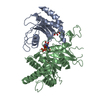
| ||||||||
| 2 | 
| ||||||||
| 3 | 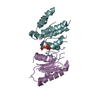
| ||||||||
| Unit cell |
|
- Components
Components
-Protein , 2 types, 6 molecules ACEBDF
| #1: Protein | Mass: 20568.152 Da / Num. of mol.: 3 Source method: isolated from a genetically manipulated source Source: (gene. exp.)  Chaetomium thermophilum (fungus) / Gene: CTHT_0014570 / Production host: Chaetomium thermophilum (fungus) / Gene: CTHT_0014570 / Production host:  #2: Protein | Mass: 33251.621 Da / Num. of mol.: 3 / Fragment: residues 42-346 Source method: isolated from a genetically manipulated source Source: (gene. exp.)  Chaetomium thermophilum (fungus) / Gene: CTHT_0022040 / Production host: Chaetomium thermophilum (fungus) / Gene: CTHT_0022040 / Production host:  |
|---|
-Non-polymers , 4 types, 8 molecules 






| #3: Chemical | | #4: Chemical | #5: Chemical | ChemComp-GOL / | #6: Chemical | ChemComp-SO4 / | |
|---|
-Experimental details
-Experiment
| Experiment | Method:  X-RAY DIFFRACTION X-RAY DIFFRACTION |
|---|
- Sample preparation
Sample preparation
| Crystal | Density Matthews: 2.69 Å3/Da / Density % sol: 54.27 % |
|---|---|
| Crystal grow | Temperature: 291.15 K / Method: vapor diffusion, sitting drop / pH: 5.5 / Details: 20% (w/v) PEG3350 and 0.1 M sodium citrate |
-Data collection
| Diffraction | Mean temperature: 100 K |
|---|---|
| Diffraction source | Source:  SYNCHROTRON / Site: SYNCHROTRON / Site:  ESRF ESRF  / Beamline: ID23-2 / Wavelength: 0.99 Å / Beamline: ID23-2 / Wavelength: 0.99 Å |
| Detector | Type: MARMOSAIC 225 mm CCD / Detector: CCD / Date: Feb 12, 2014 |
| Radiation | Protocol: SINGLE WAVELENGTH / Monochromatic (M) / Laue (L): M / Scattering type: x-ray |
| Radiation wavelength | Wavelength: 0.99 Å / Relative weight: 1 |
| Reflection | Resolution: 3.2→45.5 Å / Num. obs: 21109 / % possible obs: 99.9 % / Redundancy: 1.9 % / Rmerge(I) obs: 0.14 / Net I/σ(I): 7.2 |
- Processing
Processing
| Software |
| |||||||||||||||||||||||||||||||||||||||||||||||||||||||||||||||
|---|---|---|---|---|---|---|---|---|---|---|---|---|---|---|---|---|---|---|---|---|---|---|---|---|---|---|---|---|---|---|---|---|---|---|---|---|---|---|---|---|---|---|---|---|---|---|---|---|---|---|---|---|---|---|---|---|---|---|---|---|---|---|---|---|
| Refinement | Method to determine structure:  MOLECULAR REPLACEMENT MOLECULAR REPLACEMENTStarting model: 2fh5 Resolution: 3.2→45.467 Å / SU ML: 0.5 / Cross valid method: FREE R-VALUE / σ(F): 1.34 / Phase error: 33.26 / Stereochemistry target values: ML
| |||||||||||||||||||||||||||||||||||||||||||||||||||||||||||||||
| Solvent computation | Shrinkage radii: 0.9 Å / VDW probe radii: 1.11 Å / Solvent model: FLAT BULK SOLVENT MODEL | |||||||||||||||||||||||||||||||||||||||||||||||||||||||||||||||
| Refinement step | Cycle: LAST / Resolution: 3.2→45.467 Å
| |||||||||||||||||||||||||||||||||||||||||||||||||||||||||||||||
| Refine LS restraints |
| |||||||||||||||||||||||||||||||||||||||||||||||||||||||||||||||
| LS refinement shell |
|
 Movie
Movie Controller
Controller




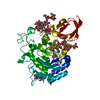
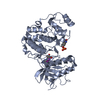
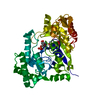

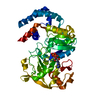
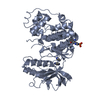
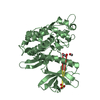
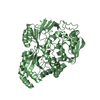
 PDBj
PDBj





